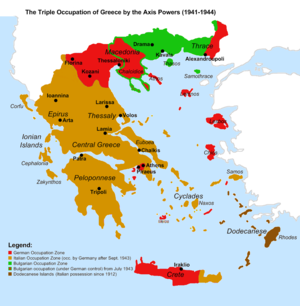Ohrana
[2][3] Bulgaria was interested in acquiring Thessalonica and Western Macedonia, under Italian and German occupation and hoped to sway the allegiance of the 80,000 Slavs who lived there at the time.
[3] However, during late 1944, when the Axis appeared to be losing the war, many Bulgarian Nazi collaborators, Ohrana members and VMRO regiment volunteers fled to the opposite camp by joining the newly founded communist SNOF.
[4] The organization managed to recruit initially 1,000 up to 3,000 armed men from the Slavophone community that lived in the western part of Greek Macedonia.
[5] The "Macedonian Question," became especially prominent after the Balkan wars in 1912–1913, following the defeat of the Ottoman Empire and the subsequent division of the Region of Macedonia between Greece, Bulgaria and Serbia.
[6][7] This continued also during 16th and 17th centuries by Ottoman historians and travellers like Hoca Sadeddin Efendi, Mustafa Selaniki, Hadji Khalfa and Evliya Çelebi.
During the 1930s under the Metaxas Regime, the government endorsed violence by nationalist bands, which sowed the seeds of bitterness that kept brewing within the local Slav-speaking population which found the opportunity to come into effect during the Second World War and the occupation of Greece by the Axis forces.
In 1942, the Bulgarian club asked assistance from the High Command in organising armed units among the Slavic-speaking population in northern Greece.
[14] The initial detachments were formed in 1943 in the district of Kastoria by Bulgarian army officer Andon Kalchev with the support of the head of the Italian occupation authorities in Kastoria, colonel Venieri,[15] who armed the local villages to help combat the growing communist threat presented by the ELAS raiding the Italian occupation forces in the district.
The uniforms of the Ohranists were supplied by the Italians and were resplendent with shoulder patches bearing the inscription "Italo-Bulgarian Committee — Freedom or Death".
In one occasion together with the 7th SS Panzer Grenadier Regiment they were responsible for a major massacre in the village of Klisoura near Kastoria, that cost the lives of 250 women and children.
[19][failed verification] The main leaders during the early phase of activity from 1941 to 1942 were Tsvetan Mladenov and Andon Kalchev in the Florina prefecture, where there were 600 men under arms.
[20] During 1944, whole Slavophone villages were armed by the occupation authorities to counterbalance the emerging power of the resistance and especially of Greek People's Liberation Army (ELAS).
This was in accordance with the agreement Ivan Mihailov and IMRO struck with Hitler and Himmler, which envisaged that these battalions would form the avant-garde of the whole Macedonian military effort in Western Macedonia and would spearhead the drives and sweeps against the ELAS forces.
[citation needed] After the declaration of war by Bulgaria on Nazi Germany in September 1944 Ivan Mihaylov arrived in German-occupied Skopje, where the Germans hoped that he could form a Macedonian puppet-state with their support.
[26] In autumn 1944 Anton Kalchev escaped northern Greece, and tried to flee with the retreating German army, but was captured in the vicinity of Bitola by communist partisans from Vardar Macedonia, and was apprehended to ELAS officials.
It foresaw unification between Yugoslav ("Vardar") and Bulgarian ("Pirin") Macedonia, as well as a return of the so-called Western Outlands to Bulgaria.
The "Slavic Committee" in Sofia (Bulgarian: Славянски Комитет) helped to attract refugees that had settled in other parts of the Eastern Bloc.
[30] The policy of communist Bulgaria towards the refugees from Greece was, at least initially, not discriminative with regard to their ethnic origin: Greek- and Slav-speakers were both categorized as Greek political emigrants and received equal treatment by state authorities.
[31] However, the end of the 1950s and the beginning of the 1960s was marked by a decisive turn in the "Macedonistic" policy of Bulgaria, which did not recognize anymore the existence of a Macedonian ethnicity different from the Bulgarian one.



